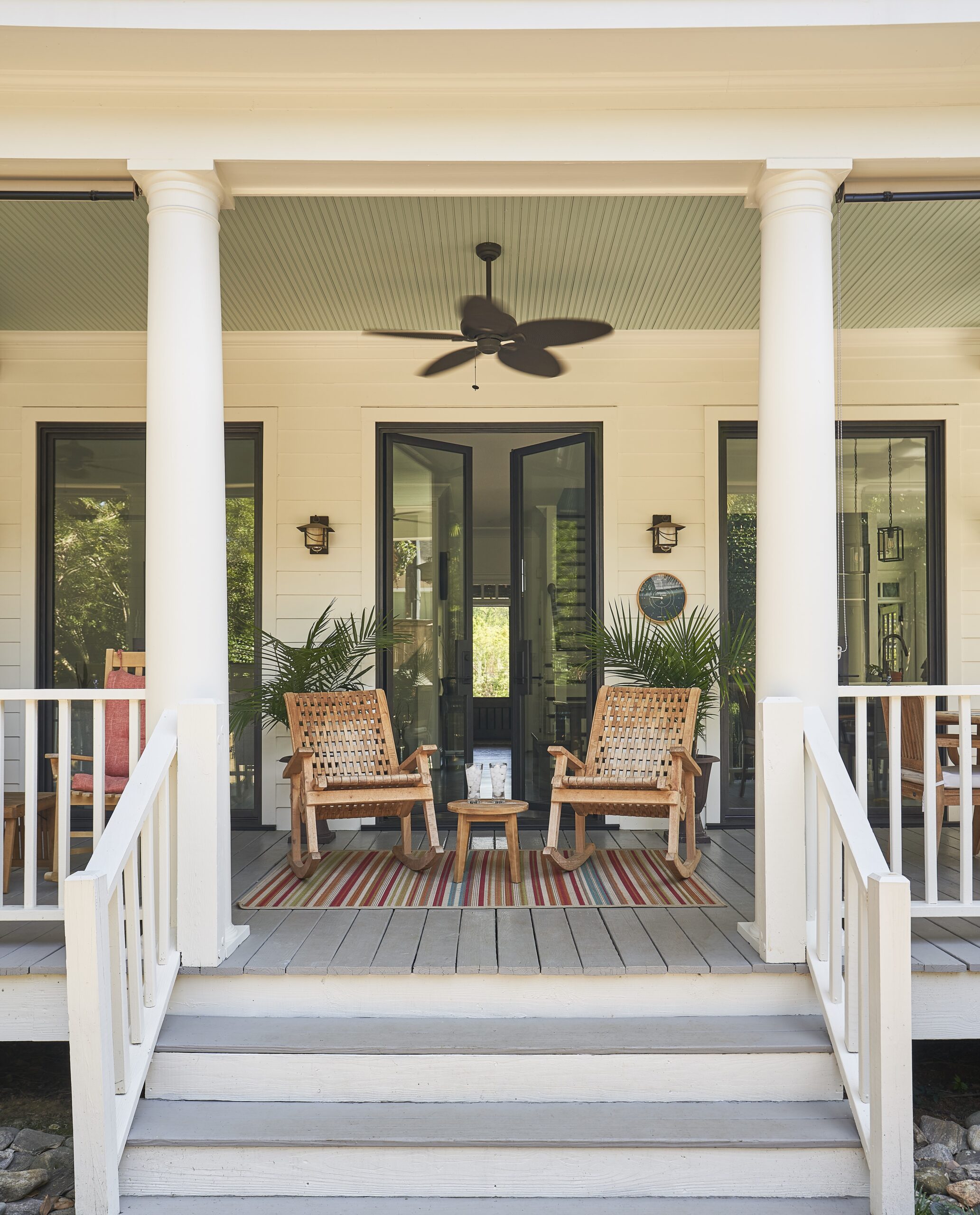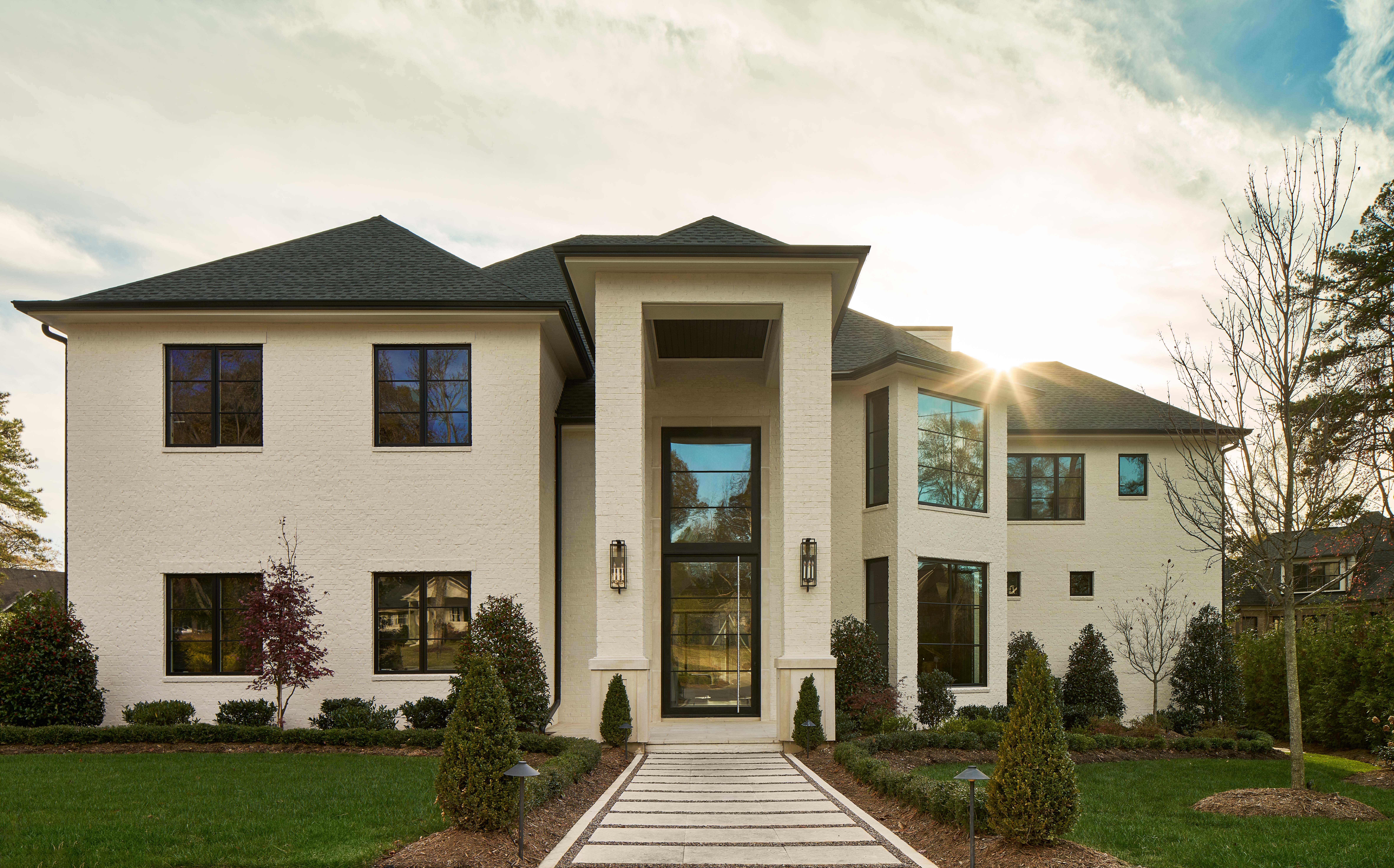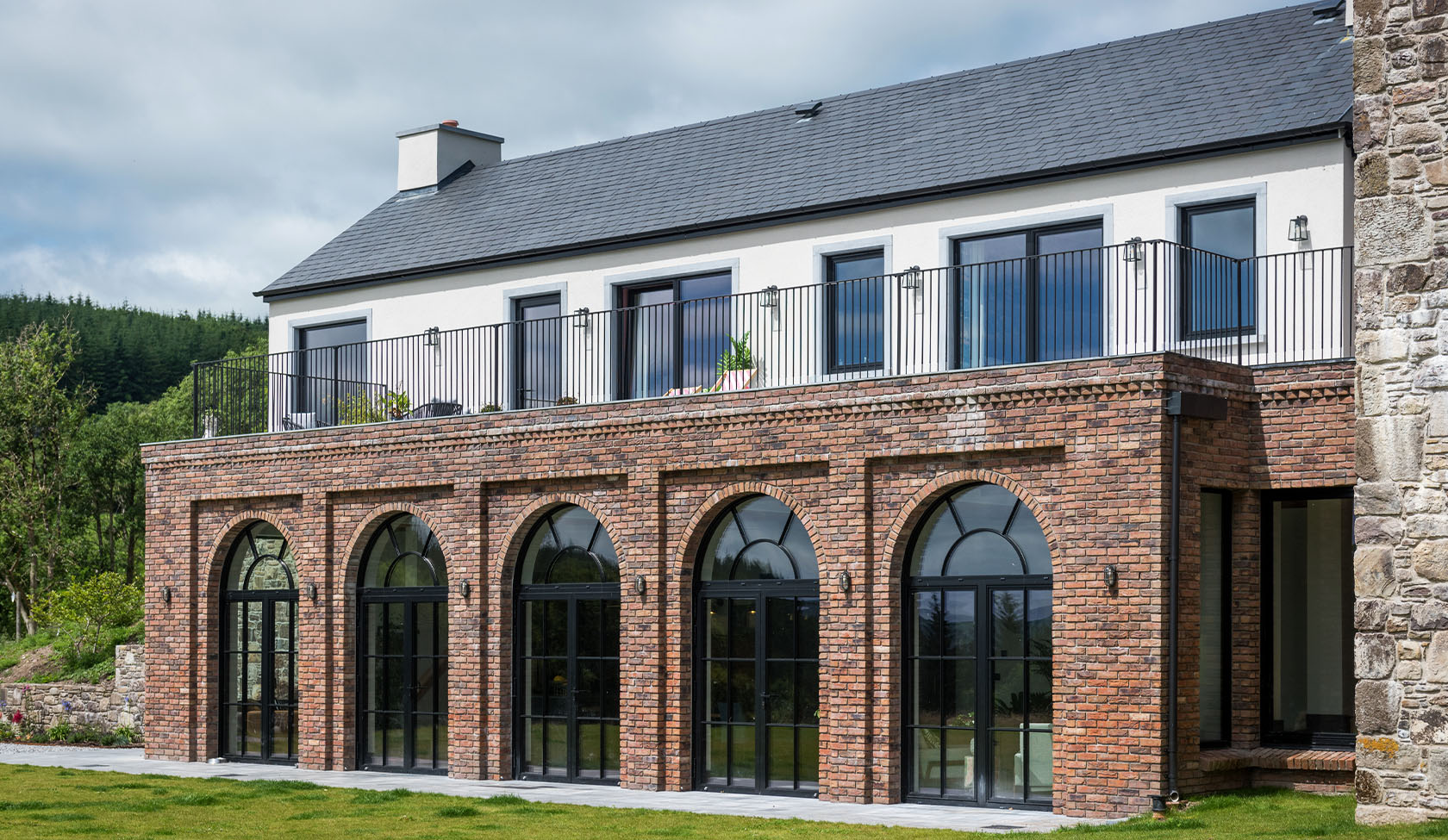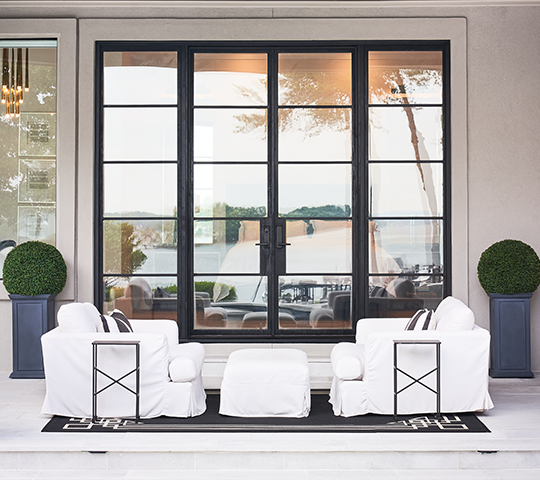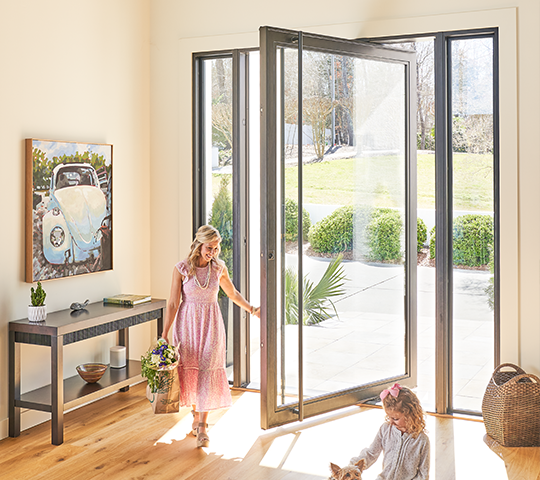Smooth, Sleek & Statement-Worthy
There are few door styles that are as unique or striking as a custom pivot door. Perhaps the most compelling feature that attracts clients to this option is how much larger they can make your entryway look. In fact, a pivot door allows you to build a much larger door than a standard swinging single door—not to mention, the eye-catching pivot point creates a conversation piece among guests, family, and friends. Interested in designing your own? Follow along to learn more about their mechanics, security, and benefits.
Pivot Doors Defined
To provide a basic definition, a pivot door is a swinging door that rotates on a vertical axis, or a spindle. Meanwhile, regular hinged doors are attached to the side of a door adjacent to the wall. Pivot doors are one of the most requested doors in luxury home design. Whether they’re internal or external, they add an air of elegance and style to any home.
Their balanced nature is also a large appeal because it allows you to have the size of a large door without the normal heaviness. Check out the visual comparison below to see how a traditional hinged door differs from a pivot door.
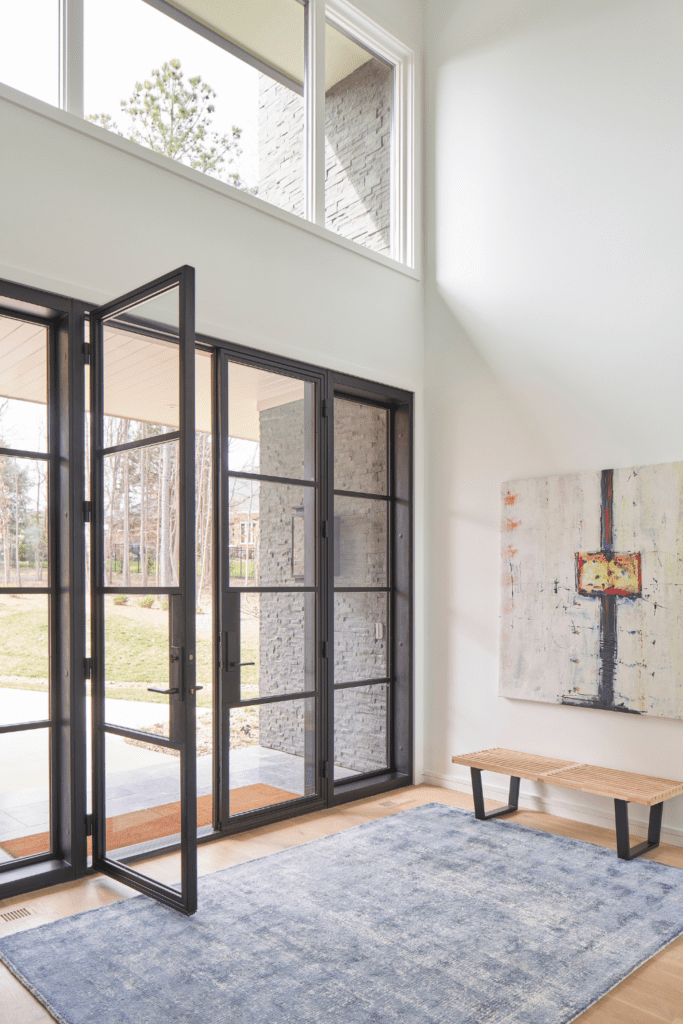
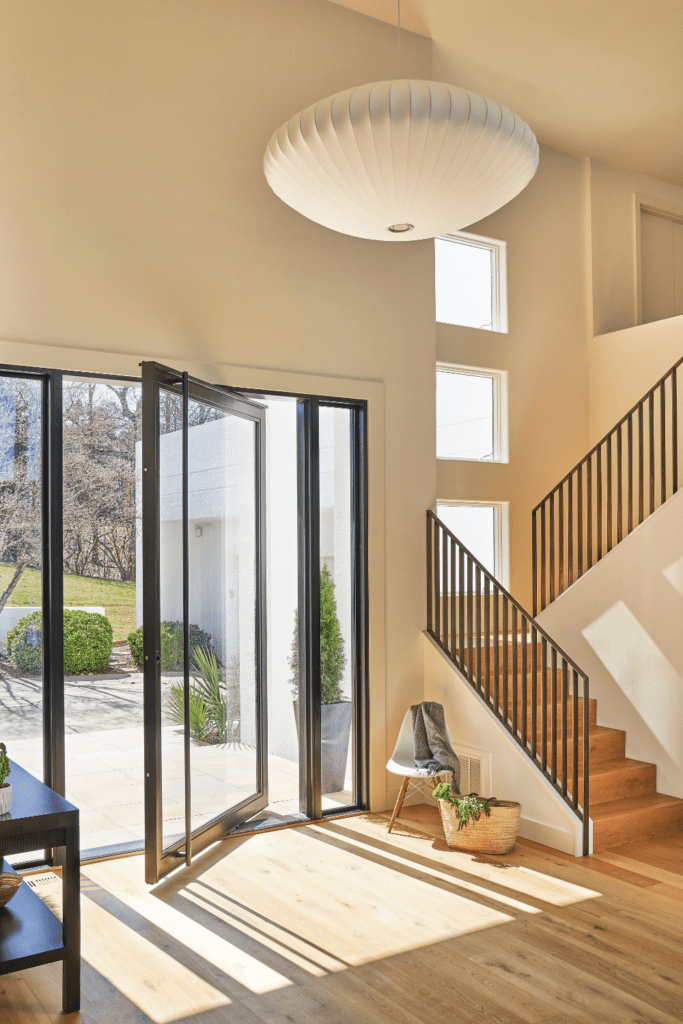
How Does a Pivot Door Work?
Essentially, a pivot door is a pivoting panel that can take on any type of custom design or measurement. Its basic elements include:
- The door panel
- A pivot system
- A top pivot
- A floor plate
- A ceiling plate
Unlike old examples, modern pivot doors don’t rotate on an extension of the vertical axis. Instead, they leverage a pivot hinge system and a top pivot that are both invisible on the finished door. Where the pivot is located depends on personal preference and the width of the door. Typically, it’s about 15” from the end, but that may change if the designer or homeowner needs a bigger or smaller opening to walk through.
Pivot Doors vs. Regular Doors: A Quick Comparison
While we’ve outlined the key details about pivot doors above, it’s important to consider how they stack up against traditional-styled doors. Understanding these key differences enables you to make the best possible design match for your current vision.
Here are a few insights about pivot doors vs. regular doors, courtesy of our specialists.
- Pivot doors can be subject to less wear-and-tear. While traditionally styled doors are pushed, pulled, and are otherwise subjected to other forces, pivot doors are primarily subject to gravity (resulting in sheared force down). This makes them more resilient to traditional use-based wear-and-tear, possibly prolonging the life of your door.
- Pivot doors can “handle” more. Resiliency goes above and beyond the context it plays in wear-and-tear. Pivot doors can be larger, heavier, and more elaborate thanks to the security the pivot mechanism holds. While hinge-attached doors are heavier on their attached side than their free-swinging side, pivot doors have a center attachment point that rotates—allowing the door to move effortlessly in the doorway. As a result, clients may have more design and manufacturing options available to them, as weight considerations are considerably nullified compared to what one would find with traditional hinged doors.
- Pivot doors offer endless possibilities. Whether you have a heavier or a more lightweight design, pivot doors can offer new levels of sophistication for double door designs and other styles, further personalizing and curating your home’s unique aesthetic.
Pivot doors, while advantageous, also have a few cons to consider as well. Some of the most critical include:
- Warping. This consideration primarily applies to pivot doors with wooden elements in them. While the centralized structure of a pivot door is stronger than your average hinged door, its unique motion can affect different materials differently. To avoid this, we recommend working closely with your Clark Hall specialist to select the best possible material for your home’s structure and projected use patterns.
- Drilling. Drilling is generally required for pivot door installation; which may deter some homeowners from pursuing the idea. While this generally cannot be avoided, Homeowners can work with their design specialist to mitigate the negative or otherwise inconvenient effects to your home and experience during the installation process.
- Airtightness. Due to how they are constructed, pivot doors may not be as airtight as traditional doors would be—which might be a concern if you live in extreme hot or cold climates. Your specialist can work with you to determine which style of door would be the most appropriate for your home’s location and unique scope of need.
Are Pivot Doors Secure?
Yes, Clark Hall’s Pivot doors are secure, offering clients peace of mind. Our doors are constructed of 14-gauge steel and double paned insulated glass ensuring privacy and security for the home.”
Plus, all of the hardware is custom made with security and durability in mind. If you’re concerned about privacy with a pivot door that features a large glass window panel, we recommend choosing a textured glass option that slightly obscures an onlooker’s view of the inside of your home—Seedy Baroque, Flemish, Cotswold textures are some of the most popular options, size permitting.
What is the Purpose of a Pivot Door?
Homeowners looking to have a large and impressive front door often choose pivot doors. With a pivot door system, the hinge points are on the top and bottom of the door, allowing the weight of the door to be transferred vertically, as opposed to hanging off the side frame. Pivot door systems are often used in modern designs and luxurious homes because of their breathtaking size and superior engineering.
The History of Pivot Doors
Although modern pivot doors seem to be a contemporary trend, the technology dates back centuries. According to FritsJurgens®, an example of an early pivot door can be found in the ancient city of Persepolis in modern-day Iran. Additionally, there are several indications of this door style found in the Gate of All Nations, a grand hall that was built between 486 and 465 B.C.
4 Benefits of Modern Pivot Doors
Whether you’re looking for an elevated style or a smoother entryway system—our pivot doors have both. Check out a few of their top advantages.
1. They expand your entryway.
The beauty of the pivot is that you can build a much larger door than a standard swinging single door. To give you an idea, we often see modern pivot doors measure at about 10 ft. and over 50” wide.
2. They make a statement.
Most clients who want a pivot door installed in their home are looking to make a statement. These doors are visually different from the average hinged doors, and they feature a very elegant door movement that captivates those who enter.
3. They’re extremely smooth.
Our pivot doors boast a very smooth operating system, and help create a seamless transition from one area to another. We often hear clients who visit our design studios say that they are “wowed” by their beauty and effortless functionality.
4. They can be completely customized.
Whether you prefer modern, ornate, or traditional styles, our experts and artisans can work closely with you to design a custom pivot door that suits your taste. Plus, choose from a range of glass styles and finishes that complement your exterior.
Feeling inspired and want to design your own custom pivot door? Check out our blog article, “How to Design a Custom Door” to learn more about the process. Then, schedule a consultation at one of our design studios—we have a few pivot doors showcased on-site, so it’s a great opportunity to get a taste for their look and feel.
Frequently Asked Questions About Pivot Doors
What is the advantage of a pivot door?
Pivot doors offer many advantages, but the biggest one is that they easily expand your entryway. These entrances give you the opportunity to build a much larger door than a standard swinging single door—for example, many of our pivot doors measure at about 10 ft. and over 50” wide. Other advantages include their statement-worthy craftsmanship, extremely smooth operating system, and complete customizability.
What is the difference between a swing door and a pivot door?
Pivot doors are doors that swing, but instead of being restrained by hinges on either side, pivot doors rotate on a vertical axis, or spindle. The pivot points are located at the very top and bottom of the door at points that are located the same distance from the edge of the frame.
Where are pivot doors used?
Pivot doors are great entry doors, giving an elegant first impression. We often recommend that pivot doors be covered so as not to leave the entryway exposed to rain and other elements that could leak through the inactive space. You can speak to a member of our sales team to see if a pivot door is right for your entryway.
Are pivot doors practical?
Pivot doors look contemporary and sophisticated, complementing modern homes exceptionally well. Practicality depends on what you are looking for. If you want to expand your entryway and prefer a pivot over double doors, pivot doors are your best choice. However, if you have a smaller, restricted entryway, a single door would better suit your needs.
Learn more about iron doors today.
Clarkhall contact form - Dual Column
"*" indicates required fields

